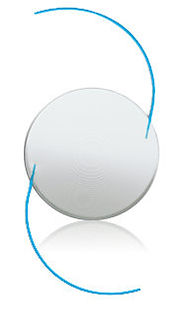See the way you were meant to see with precise vision!
General office line:
937-427-2020
To schedule a FREE LASIK consult:
937-643-2020


Advanced Lifestyle Bifocal Implants are a type of premium implant lens that help restore distance, intermediate and near vision and are used with Cataract Surgery or Refractive Lens Exchange (RLE). These advanced lenses add to the out-of-pocket expense for your surgery, they are NOT covered by insurances or Medicare.
Unlike the “standard” Monofocal Implant Lenses, these advanced technology lenses provide excellent vision at more than one distance or focal point and correct for astigmatism resulting in better sharpness and less dependence on glasses or contacts after your surgery. Depending on your specific vision requirements, our best cataract surgeons Drs. Stahl & Knowles can recommend the lens that will best fit your lifestyle and your goals after surgery. Many of our patients are enjoying their lives often without glasses and contacts after modern cataract surgery with Advanced lifestyle lenses.

ADVANCED LIFESTYLE BIFOCAL IMPLANT LENSES
Presbyopia- This condition causes people to lose their near vision around the age of 40. The eyes have less accommodation ability. This means the eye loses the ability to change the shape of the lens inside the eye that it uses to focus on things up close. If you have been told that you have presbyopia that means you can’t see things up close and your doctor may have recommended reading glasses or bifocals.
Symfony® Lens and Synergy® Multifocal Implant

The Symfony (pronounced “symphony”) and Tecnis® Synergy Implant Lenses are 4th generation bifocal implant lenses that use advanced diffractive optics work to create both distance and near focal points, helping patients to see both near and far without corrective lenses.
These are extended depth of focus lenses, the newest and first of its class. The Symfony has good distance vision, very good intermediate vision, and fair near vision. While the Synergy now also improves the near vision even more.
The Symfony lens was the first multifocal implant approved by the FDA to correct for astigmatism. It is similar to Eyhance Lens and Vivity Lens. It has been our experience that patients who choose the Symfony or Synergy lenses experience less night glare, halos and starbursts and better over all night vision than prior generation bifocal and trifocal implant lens options.
Pros: good distance, good intermediate and fair near, less night vision disturbance than with prior generation lenses.
Cons: Some glare/halos with night driving that improves over time, may need readers for very small print.
PanOptix® Implant Lens

Like Symfony® Lens and Tecnis® Multifocal Lens, the Acrysof PanOptix® lens uses high tech diffractive optics to create focal points at distance, intermediate and near. The PanOptix® is a trifocal design and an improvement over the older Acrysof ReSTOR design. In comparison to older generation designs the PanOptix® has better intermediate vision and less night vision disturbance.
The PanOptix® implant lens, like the Symfony lens and Tecnis Multifocal lenses, is FDA approved to correct for astigmatism as well.
Pros: good distance, good intermediate and near vision, less night vision disturbance than with prior generation lenses.
Cons: some glare/halos with night driving that improves over time, night vision in dim conditions may not be as good as with some other lens designs.
Astigmatism- is where the cornea, the outer window of the eye, is curved more in one direction than the other. The eye is shaped like a football so this causes multiple points of focus and blurry vision.

ToricPlus Eyehance®/Vivity®
The Toric Plus is an extended depth of focus design that treats astigmatism and features good intermediate vision as well as good distance vision (better than the standard monofocal lens).
With the new "plus" design over-the-counter reading glasses can be worn for near vision.
Pros: good distance vision, good intermediate vision, corrects astigmatism, can wear over-the-counter readers.
Cons: will need reading glasses
Astigmatism- is where the cornea, the outer window of the eye, is curved more in one direction than the other. The eye is shaped like a football so this causes multiple points of focus and blurry vision.
If you decide to have an Advance Lifestyle bifocal implant lens or Toric Intra-Ocular Lens (IOL), our staff will review your questions and fully explain any additional fees related to the lens implant that you might be responsible for. Most insurances including Medicare cover the cost of the cataract surgery, the surgical facility fee for cataract surgery, and anesthesia fees, but not the cost of Advance Lifestyle bifocal implant lens or Toric Implant Lens.
If you are having Refractive Lens Exchange, all of these fees are included in one global fee. Our staff will be pleased to review any costs and discuss special financing options with approved credit, should you decide that an Advance Lifestyle Bifocal Implant Lens or Toric Implant Lens is the best choice for you.
